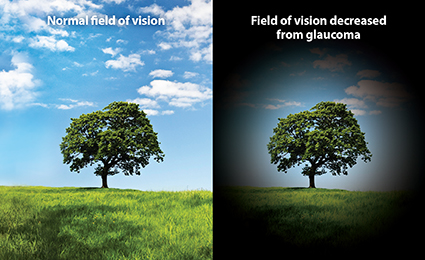Glaucoma
Glaucoma is a disease of the optic nerve of the eye that can cause progressive loss of vision and blindness. For healthy vision, the eye takes in information from the outside world and sends the information to the brain through the optic nerve. The optic nerve is like the cable wire, and damage to the optic nerve from glaucoma often has no symptoms. The nerve damage generally cannot be reversed, but there are treatments available that can slow or stop the progression. Treatments range from eye drops, office-based laser treatments, minimally-invasive surgery, to incisional surgery.
While there is much about glaucoma that scientists and doctors still do not understand, it is clear that the intraocular pressure (IOP) plays an important role. Elevated IOP puts the eye at a much higher risk of developing glaucoma, and lowering the IOP with treatment can slow or stop further glaucoma damage. However, some patients develop glaucoma without having elevated IOP, and some patients with elevated IOP never develop damage to the optic nerve from glaucoma. The regular monitoring of patients with thorough eye exams and advanced diagnostic testing is therefore essential in order to initiate appropriate treatments to preserve vision.
There are two major types of glaucoma:
Open-Angle Glaucoma is the most common type. Inside of the eye, there is a constant circulation of fluid. There is a pump mechanism for creating the fluid and a drain mechanism for allowing drainage of the fluid back into the veins of the body. In open-angle glaucoma, the function of the drain decreases with time as it becomes clogged, but the pump mechanism continues to make fluid, causing the pressure to rise inside of the eye. The elevated IOP causes damage to the optic nerve in the form of glaucoma. The elevated IOP does not cause symptoms or discomfort.
Closed-Angle is less common in the United States. It usually occurs quickly when the drainage area of the eye becomes completely blocked by other structures inside the eye. The eye pressure builds rapidly to dangerous levels and usually causes symptoms. Symptoms can include: halos around lights, headaches, nausea, vomiting, and severe pain. If the eye pressure is not rapidly lowered, permanent blindness can occur.

